Generation of Hydrogen, Lignin and Sodium Hydroxide from Pulping Black Liquor by Electrolysis
Abstract
:1. Introduction
2. Methods and Materials
2.1. Black Liquor
2.2. Electrolysis of Black Liquor
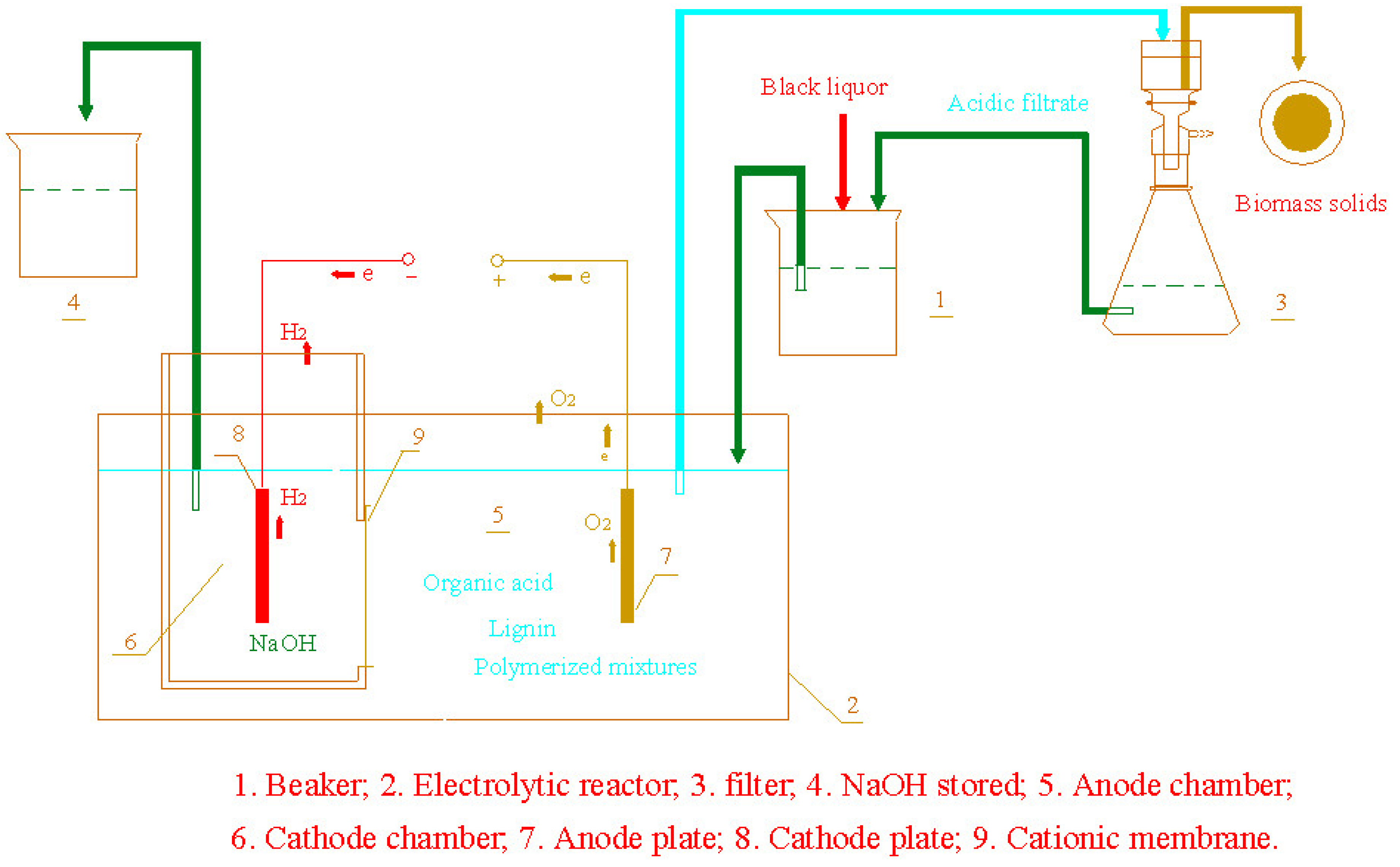
2.3. Description of the Treatment Process
2.4. Analytical Methods
3. Results
3.1. Identification of Main Products
| Products | Masses (g) |
|---|---|
| Sodium hydroxide | 30.70 |
| Hydrogen gas | 0.82 |
| Biomass solids | 52.10 |
| Residue solids | 33.63 |
3.2. Energy Balance in Treating 1000 mL of Black Liquor
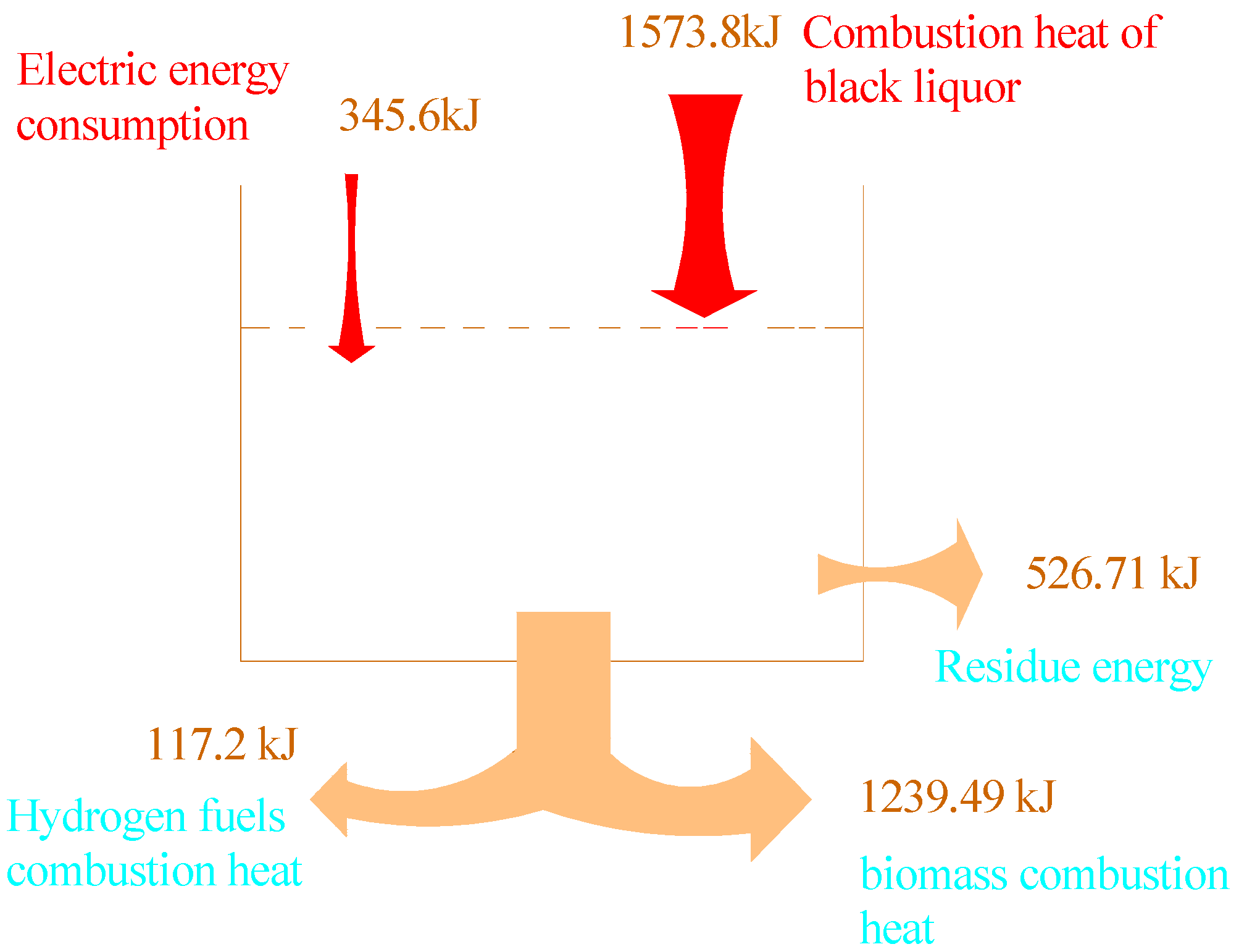
3.3. Investigation of the Composition of the Biomass Solids
3.3.1. Generated Biomass Solids
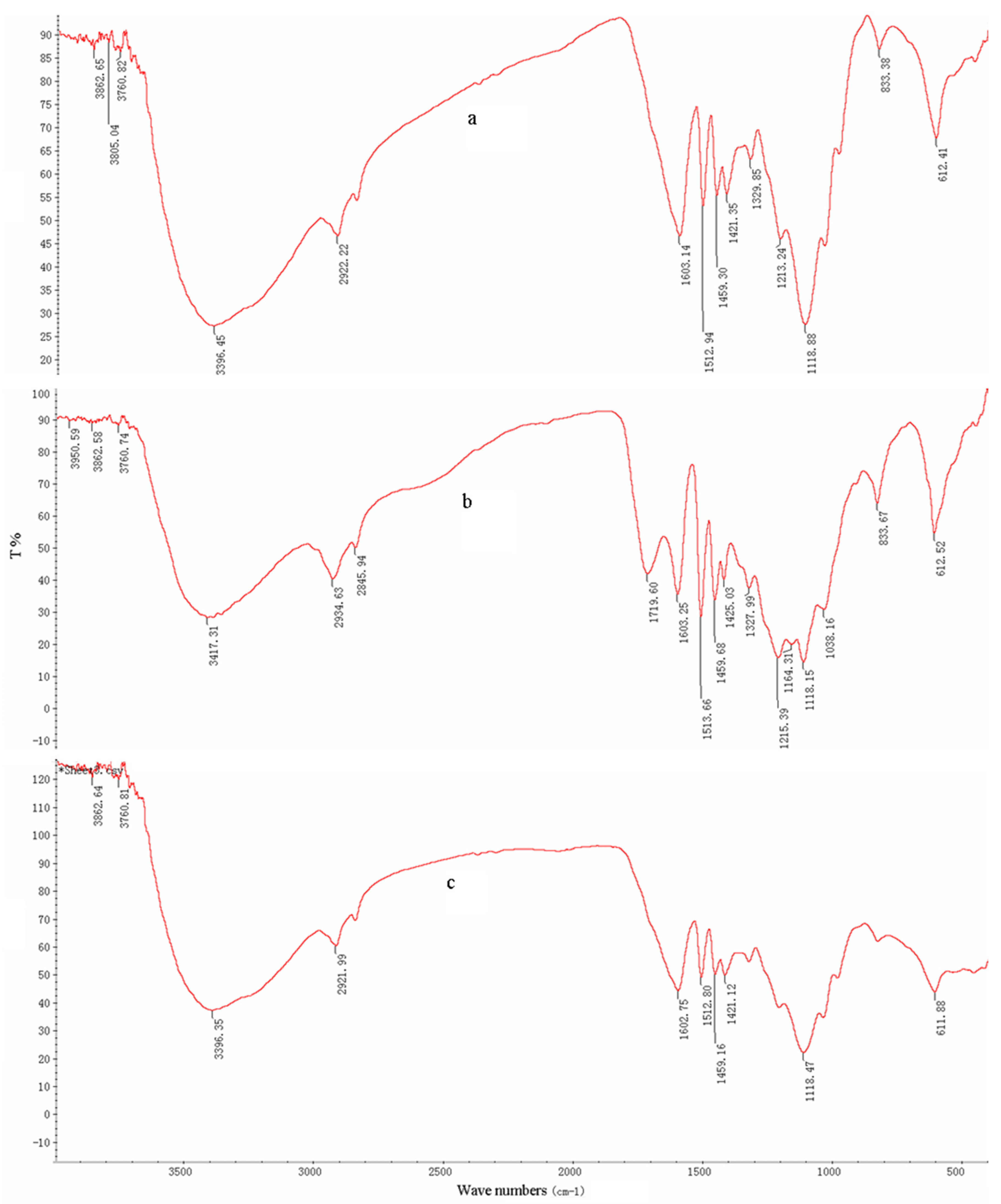
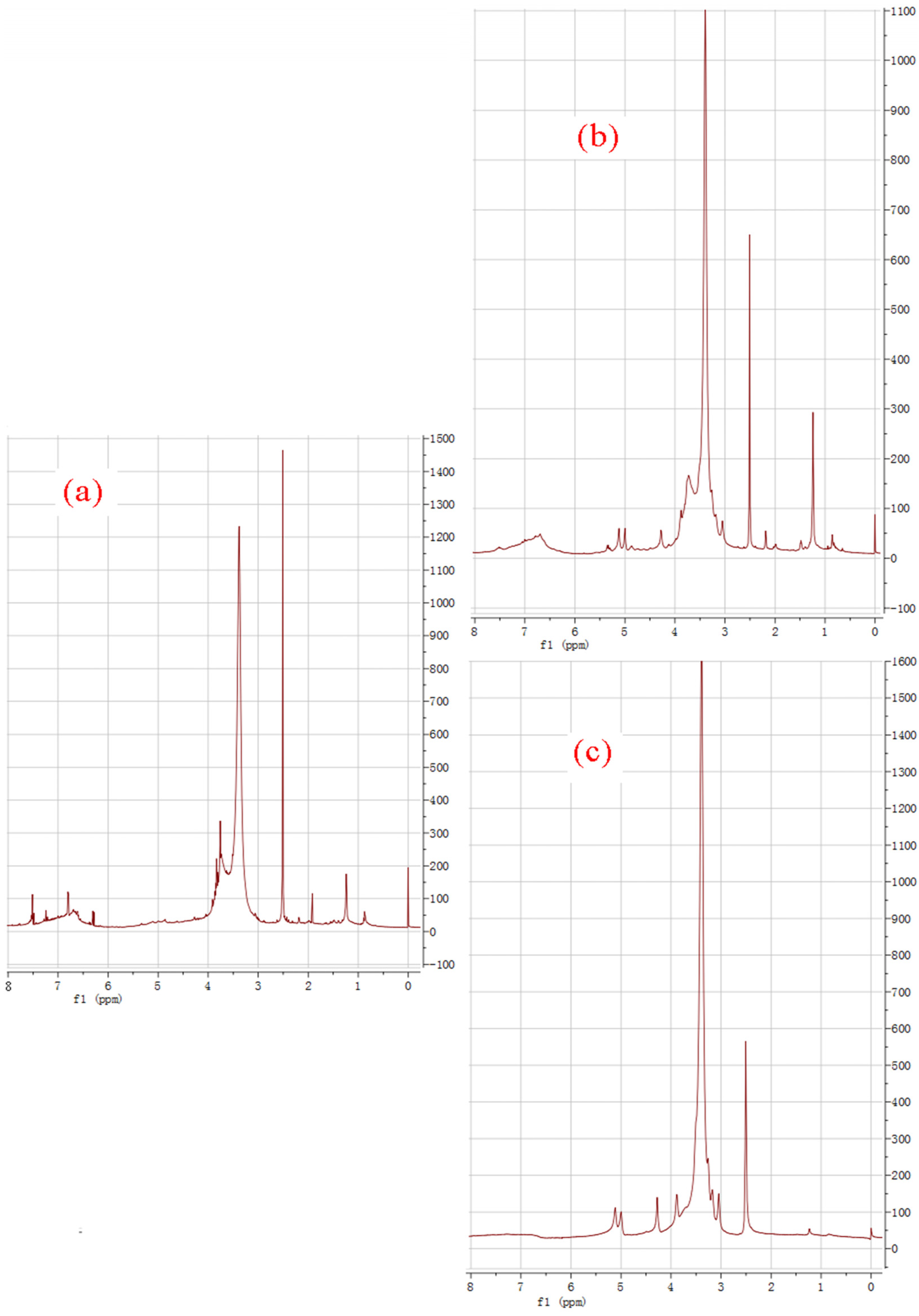
3.3.2. Precipitated Lignin
3.3.3. Other Organic Precipitates
3.4. Investigation of the Working Mechanisms of Black Liquor Electrolysis
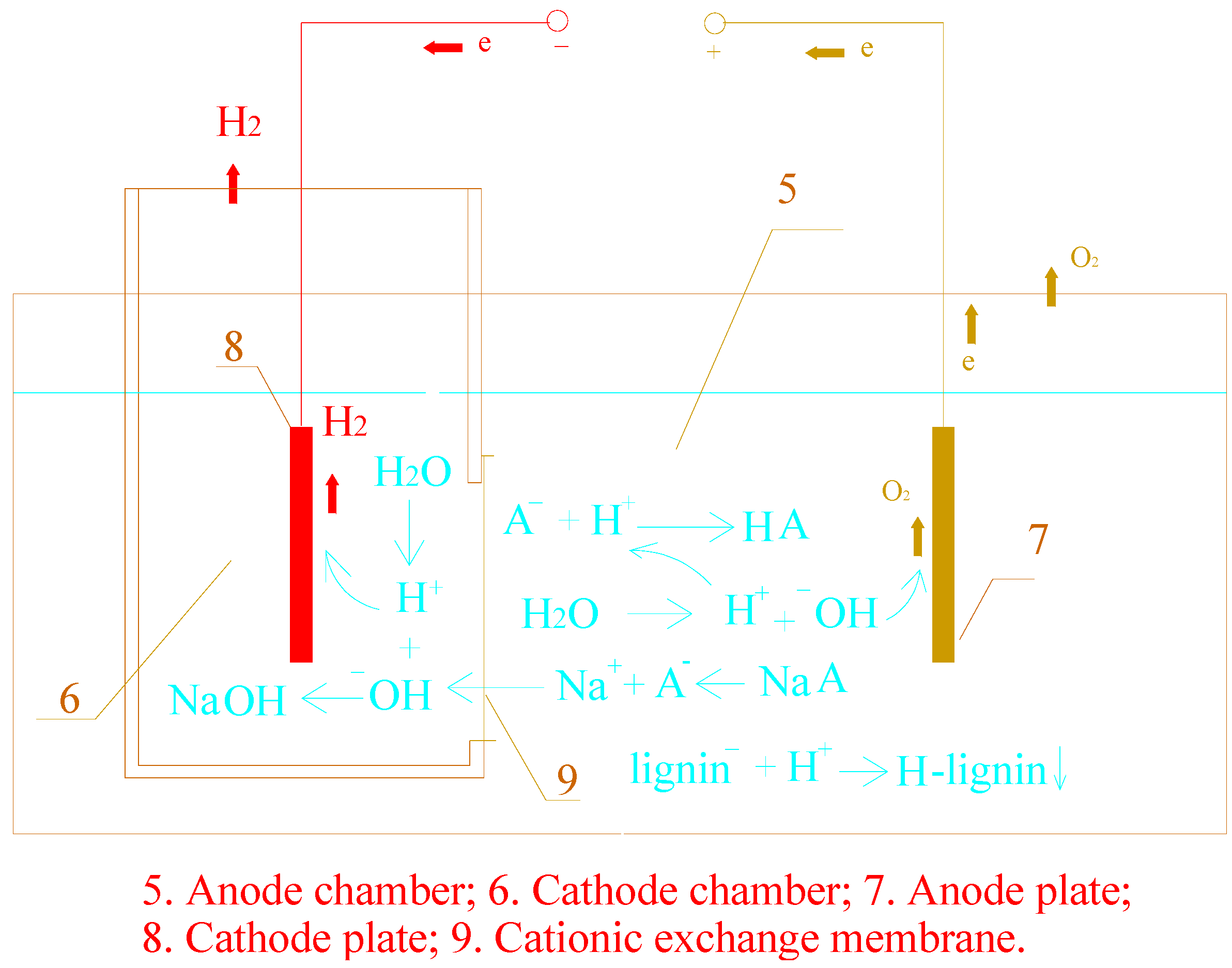
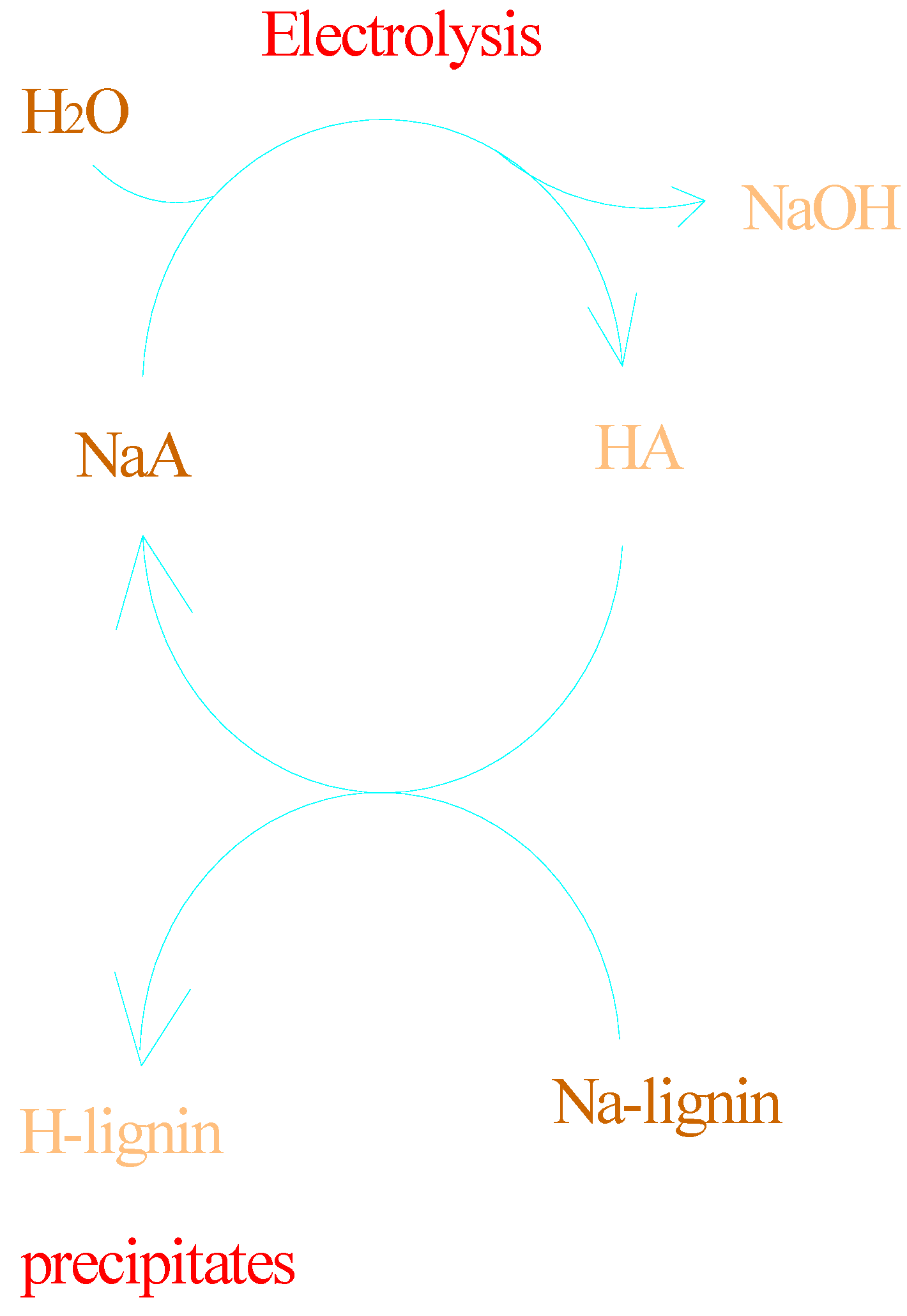
4. Discussion
5. Conclusions
Supplementary Materials
Acknowledgments
Author Contributions
Conflicts of Interest
References
- Hamaguchi, M.; Cardoso, M.; Vakkilainen, E. Alternative Technologies for Biofuels Production in Kraft Pulp Mills—Potential and Prospects. Energies 2012, 5, 2288–2309. [Google Scholar]
- Zeng, J.; Tong, Z.; Wang, L.; Zhu, J.Y.; Ingram, L. Isolation and structural characterization of sugarcane bagasse lignin after dilute phosphoric acid plus steam explosion pretreatment and its effect on cellulose hydrolysis. Bioresour. Technol. 2014, 154, 274–281. [Google Scholar] [PubMed]
- Nong, G.; Huang, L.; Mo, H.; Wang, S. Investigate the variability of gas compositions and thermal efficiency of bagasse black liquor gasification. Energy 2013, 49, 178–181. [Google Scholar] [CrossRef]
- Saw, W.L.; Nathan, G.J.; Ashman, P.J.; Hupa, M. Influence of droplet size on the release of atomic sodium from a burning black liquor droplet in a flat flame. Fuel 2010, 89, 1840–1848. [Google Scholar] [CrossRef]
- Yang, C.Y.; Niu, Y.; Su, H.J.; Wang, Z.; Tao, F.; Wang, X.; Tang, H.; Ma, C.; Xu, P. A novel microbial habitat of alkaline black liquor with very high pollution load: Microbial diversity and the key members in application potentials. Bioresour. Technol. 2010, 101, 1737–1744. [Google Scholar] [CrossRef] [PubMed]
- Maček, A. Research on combustion of black-liquor drops. Prog. Energy Combust. Sci. 1999, 25, 275–304. [Google Scholar] [CrossRef]
- Carlsson, P.; Wiinikka, H.; Marklund, M.; Grönberg, C.; Pettersson, E.; Lidman, M.; Gebart, R. Experimental investigation of an industrial scale black liquor gasifier. 1. The effect of reactor operation parameters on product gas composition. Fuel 2010, 89, 4025–4034. [Google Scholar] [CrossRef]
- Maciel, A.V.; Job, A.E.; Mussel, W.N.; Pasa, V.M.D. Pyrolysis and auto-gasification of black liquor in presence of ZnO: An integrated process for Zn/ZnO nanostructure production and bioenergy generation. Biomass Bioenergy 2012, 46, 538–545. [Google Scholar] [CrossRef]
- Naqvi, M.; Yan, J.; Dahlquist, E. Bio-refinery system in a pulp mill for methanol production with comparison of pressurized black liquor gasification and dry gasification using direct causticization. Appl. Energy 2012, 90, 24–31. [Google Scholar] [CrossRef]
- García-Trenco, A.; Martínez, A. The influence of zeolite surface-aluminum species on the deactivation of CuZnAl/zeolite hybrid catalysts for the direct DME synthesis. Catal. Today 2014, 227, 144–153. [Google Scholar] [CrossRef]
- Eriksson, H.; Harvey, S. Black liquor gasification—Consequences for both industry and society. Energy 2004, 29, 581–612. [Google Scholar] [CrossRef]
- Zhang, X.; Wang, T.; Ma, L.; Zhang, Q.; Huang, X.; Yu, Y. Production of cyclohexane from lignin degradation compounds over Ni/ZrO2–SiO2 catalysts. Appl. Energy 2013, 112, 533–538. [Google Scholar] [CrossRef]
- Yoshikawa, T.; Shinohara, S.; Yagi, T.; Ryumon, N.; Nakasaka, Y.; Tagoa, T.; Masudaa, T. Production of phenols from lignin-derived slurry liquid using iron oxide catalyst. Appl. Catal. B 2014, 146, 289–297. [Google Scholar] [CrossRef]
- Welker, C.M.; Balasubramanian, V.K.; Petti, C.; Rai, K.M.; DeBolt, S.; Mendu, V. Engineering plant biomass lignin content and composition for biofuels and bioproducts. Energies 2015, 8, 7654–7676. [Google Scholar] [CrossRef]
- Guo, F.; Xiu, Z.; Liang, Z. Synthesis of biodiesel from acidified soybean soapstock using a lignin-derived carbonaceous catalyst. Appl. Energy 2012, 98, 47–52. [Google Scholar] [CrossRef]
- Minu, K.; Kurian Jiby, K.; Kishore, V.V.N. Isolation and purification of lignin and silica from the black liquor generated during the production of bioethanol from rice straw. Biomass Bioenergy 2012, 39, 210–217. [Google Scholar] [CrossRef]
- Nong, G.; Chen, S.; Xu, Y.; Huang, L.; Zou, Q.; Li, S.; Mo, H.; Zhu, P.; Cen, W.; Wang, S. Artificial photosynthesis of oxalate and oxalate-based polymer by a photovoltaic reactor. Sci. Rep. 2014, 4. [Google Scholar] [CrossRef] [PubMed]
- Han, B.; Steen, S.M., III; Mo, J.; Zhang, F. Electrochemical performance modeling of a proton exchange membrane electrolyzer cell for hydrogen energy. Int. J. Hydrogen Energy 2015, 40, 7006–7016. [Google Scholar] [CrossRef]
- Ghatak, H.R. Electrolysis of black liquor for hydrogen production: Some initial findings. Int. J. Hydrogen Energy 2006, 31, 934–938. [Google Scholar]
- Chen, Y.X.; Lavacchi, A.; Miller, H.A.; Bevilacqua, M.; Filippi, J.; Innocenti, M.; Marchionni, A.; Oberhauser, W.; Wang, L.; Vizza, F. Nanotechnology makes biomass electrolysis more energy efficient than water electrolysis. Nat. Commun. 2014, 5. [Google Scholar] [CrossRef] [PubMed]
- Hong, J.G.; Zhang, B.; Glabman, S.; Uzal, N.; Dou, X.; Zhang, H.; Wei, X.; Chen, Y. Potential ion exchange membranes and system performance in reverse electrodialysis for power generation: A review. J. Membr. Sci. 2015, 486, 71–88. [Google Scholar] [CrossRef]
- Chanda, D.; Hnát, J.; Paidar, M.; Schauer, J.; Bouzek, K. Synthesis and characterization of NiFe2O4 electrocatalyst for the hydrogen evolution reaction in alkaline water electrolysis using different polymer binders. J. Power Sources 2015, 285, 217–226. [Google Scholar] [CrossRef]
- Nie, X.; Luo, W.; Janik, M.J.; Asthagiri, A. Reaction mechanisms of CO2 electrochemical reduction on Cu(III) determined with density functional theory. J. Catal. 2014, 312, 108–122. [Google Scholar] [CrossRef]
- Sricharoenchaikul, V.; Frederick, W.J., Jr.; Agrawal, P. Carbon distribution in char residue from gasification of Kraft black liquor. Biomass Bioenergy 2003, 25, 209–220. [Google Scholar] [CrossRef]
- Lin, X.; Sui, S.; Tan, S.; Pittman, C.U., Jr.; Sun, J.; Zhang, Z. Fast pyrolysis of four lignins from different isolation processes using Py-GC/MS. Energies 2015, 8, 5107–5121. [Google Scholar] [CrossRef]
- Wen, J.; Sun, S.; Yuan, T.; Xu, F.; Sun, R. Understanding the chemical and structural transformations of lignin macromolecule during torrefaction. Appl. Energy 2014, 121, 1–9. [Google Scholar] [CrossRef]
- Bordado, J.C.M.; Gomes, J.F.P. Atmospheric emissions of Kraft pulp mills. Chem. Eng. Process. 2002, 41, 667–671. [Google Scholar] [CrossRef]
- Budzianowski, W.M. Negative carbon intensity of renewable energy technologies involving biomass or carbon dioxide as inputs. Renew. Sustain. Energy Rev. 2012, 16, 6507–6521. [Google Scholar] [CrossRef]
© 2015 by the authors; licensee MDPI, Basel, Switzerland. This article is an open access article distributed under the terms and conditions of the Creative Commons by Attribution (CC-BY) license (http://creativecommons.org/licenses/by/4.0/).
Share and Cite
Nong, G.; Zhou, Z.; Wang, S. Generation of Hydrogen, Lignin and Sodium Hydroxide from Pulping Black Liquor by Electrolysis. Energies 2016, 9, 13. https://doi.org/10.3390/en9010013
Nong G, Zhou Z, Wang S. Generation of Hydrogen, Lignin and Sodium Hydroxide from Pulping Black Liquor by Electrolysis. Energies. 2016; 9(1):13. https://doi.org/10.3390/en9010013
Chicago/Turabian StyleNong, Guangzai, Zongwen Zhou, and Shuangfei Wang. 2016. "Generation of Hydrogen, Lignin and Sodium Hydroxide from Pulping Black Liquor by Electrolysis" Energies 9, no. 1: 13. https://doi.org/10.3390/en9010013
APA StyleNong, G., Zhou, Z., & Wang, S. (2016). Generation of Hydrogen, Lignin and Sodium Hydroxide from Pulping Black Liquor by Electrolysis. Energies, 9(1), 13. https://doi.org/10.3390/en9010013







